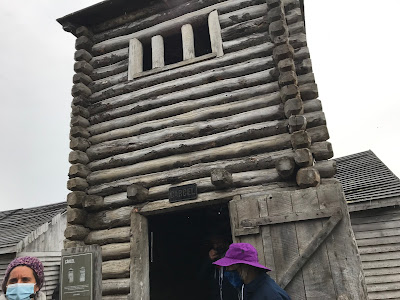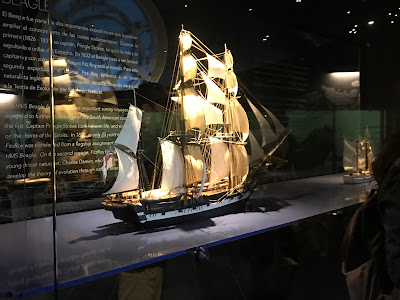February 7, 2022
NAUTICAL TERM OF THE DAY ~ Taken aback
In this dangerous situation, the wind is on the wrong side of the sails, pressing them back against the mast and forcing the ship astern. This was most often caused by an inattentive helmsman who had allowed the ship to head up into the wind.
 |
| The Star at the dock with the Strait of Magellan behind her |
The region is known for its sheep production, primarily raised for meat, because alpaca wool is so superior to sheep's wool.
Our excursion today took us to the Strait of Magellan park. Imagine our surprise when we learned that the strait is...well, crooked. There is a deep V in the middle of it and it meanders quite a bit.
Of course, Argentina, the UK, the US and a host of other countries also claim that long spindly arm of land but Anna waved that away as mere detail. What other country has a monument celebrating their ownership of that bit of Antarctica, whether anyone else acknowledges it or not?
As unforgiving as the climate is in the area (48 degrees with rain showers--and bear in mind this is high summer at the bottom of the world!), there were already tribes of people living here when Magellan first arrived. The first natives he encountered were quite tall, upwards of ten feet according his accounts, though this smacks of the tales the Israelite spies relayed to Moses describing themselves as "grasshoppers" in the Canaanites' sight. Magellan called the natives "Patagones" because their feet were so large.
 |
| The DH with a "Monkey Puzzle" tree |
Europeans had difficulty living in Patagonia, too. The first attempt at settlement ended in disaster with the location christened "Fort Famine."
The second attempt, Fort Bulnes, was built on a better site, higher up at 2500 ft. with a commanding view of the western entrance to the Strait. It had corresponding better luck. We toured a replica of the settlement that included a church with special living quarters set aside for the priest, and a jail, reserved mostly for those who would not work.
I understand why explorers like Magellan wanted to set sail. He was out to find yet another route to the Spice Islands of the East, to discover land he could claim in the name of his sovereign, and make a fortune and a name for himself. Unfortunately, it didn't turn out well for him personally. One by one, he lost ships from his five vessel armada. After discovering the Strait that bears his name, Magellan went on to be killed in the Philippines. And finally, three years after leaving Europe, one vessel, the smallest of the five ships, the Nao Victoria, limped back to port with only 18 souls on board. Still, Magellan's place in history is secured.
But what about those who left their homes in Europe to settle in a strange, and inhospitable land? My own family tree forks abruptly in the 1600's when my ancestors left England for America. I've always suspected they were somehow in trouble in the Old Country. Why else give up conveniences like already built outhouses? Fields that had been cleared for planting? Familiar plants and animals? Familiar...everything?In the early 1500's, did the settlers at Ft. Bulnes really think life would be better at the bottom of the world than it was in Spain? Or were they simply out of options?
You've no doubt heard of A and B personality types. There is another. It's Type T--the risk taker. These are the ones who can't stand not knowing what's around the next bend in the road. They test the limits. They color outside the lines. They are the sort who might gamble away their family's home on the turn of a card in the hope of making their fortune in one bold stroke. (My great-grandfather once did exactly that and my great-grandmother left him for a time over it! However, by the time I knew them, she owned 3 homes in 3 different states. Though I don't think he managed to give them to her playing cards.) Anyway, I suspect the ship that carried those colonists to the future Fort Bulnes was full to bursting with Type T's.
Along with a few B's who couldn't figure a way to wiggle out of it...
And now the DH will add a few thousand words to this post in the form of pictures!
More soon...



I took this same Viking excursion in 2020 and enjoyed it very much. Good to see someone talking a bit about the history of the early settlers as well as about the native tribes. We had 60 mph/100 kph winds that day. Had to shelter in the lee of the buildings. Viking had a small shuttle bus taking us from terminal building to ship as no one could walk the dock and there were no ropes to hold on to like in town
ReplyDeleteWow! Very thankful not to have had to fight those kind of winds! When I use my POC outside, I always feel like that precious little bolus of O2 it gives me gets whipped away in windy conditions. We've really been blessed with excellent weather so far!
DeleteThe courage of those early explorers! Your cruise looks like a wonderful way to get a taste of the area.
ReplyDelete